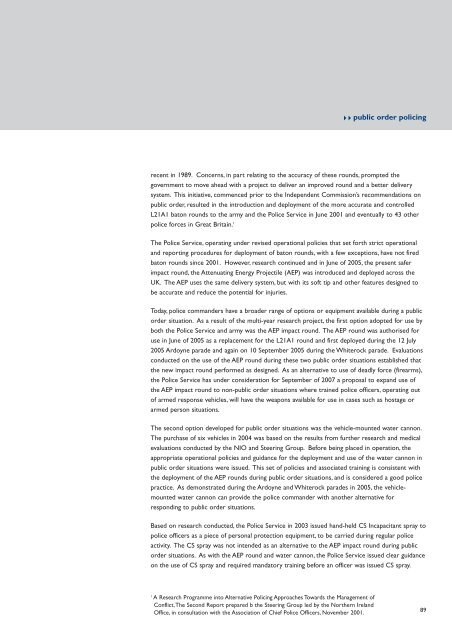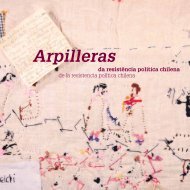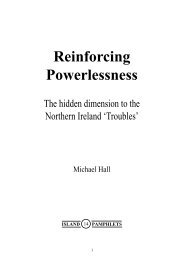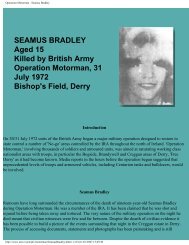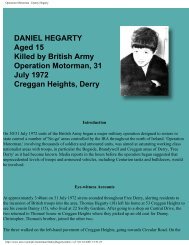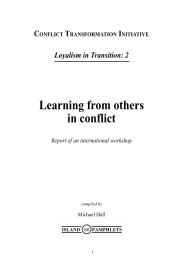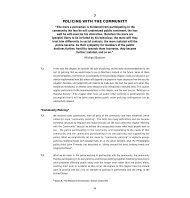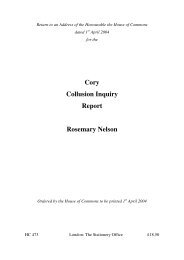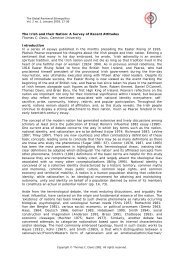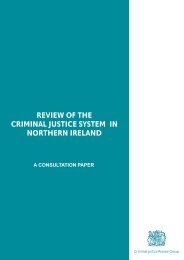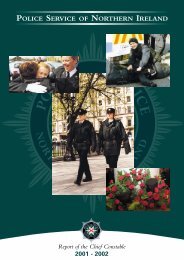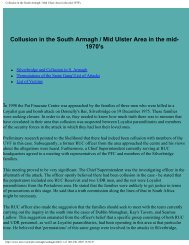11293 report 19 - CAIN - University of Ulster
11293 report 19 - CAIN - University of Ulster
11293 report 19 - CAIN - University of Ulster
Create successful ePaper yourself
Turn your PDF publications into a flip-book with our unique Google optimized e-Paper software.
public order policingrecent in <strong>19</strong>89. Concerns, in part relating to the accuracy <strong>of</strong> these rounds, prompted thegovernment to move ahead with a project to deliver an improved round and a better deliverysystem. This initiative, commenced prior to the Independent Commission’s recommendations onpublic order, resulted in the introduction and deployment <strong>of</strong> the more accurate and controlledL21A1 baton rounds to the army and the Police Service in June 2001 and eventually to 43 otherpolice forces in Great Britain. 1The Police Service, operating under revised operational policies that set forth strict operationaland <strong>report</strong>ing procedures for deployment <strong>of</strong> baton rounds, with a few exceptions, have not firedbaton rounds since 2001. However, research continued and in June <strong>of</strong> 2005, the present saferimpact round, the Attenuating Energy Projectile (AEP) was introduced and deployed across theUK. The AEP uses the same delivery system, but with its s<strong>of</strong>t tip and other features designed tobe accurate and reduce the potential for injuries.Today, police commanders have a broader range <strong>of</strong> options or equipment available during a publicorder situation. As a result <strong>of</strong> the multi-year research project, the first option adopted for use byboth the Police Service and army was the AEP impact round. The AEP round was authorised foruse in June <strong>of</strong> 2005 as a replacement for the L21A1 round and first deployed during the 12 July2005 Ardoyne parade and again on 10 September 2005 during the Whiterock parade. Evaluationsconducted on the use <strong>of</strong> the AEP round during these two public order situations established thatthe new impact round performed as designed. As an alternative to use <strong>of</strong> deadly force (firearms),the Police Service has under consideration for September <strong>of</strong> 2007 a proposal to expand use <strong>of</strong>the AEP impact round to non-public order situations where trained police <strong>of</strong>ficers, operating out<strong>of</strong> armed response vehicles, will have the weapons available for use in cases such as hostage orarmed person situations.The second option developed for public order situations was the vehicle-mounted water cannon.The purchase <strong>of</strong> six vehicles in 2004 was based on the results from further research and medicalevaluations conducted by the NIO and Steering Group. Before being placed in operation, theappropriate operational policies and guidance for the deployment and use <strong>of</strong> the water cannon inpublic order situations were issued. This set <strong>of</strong> policies and associated training is consistent withthe deployment <strong>of</strong> the AEP rounds during public order situations, and is considered a good policepractice. As demonstrated during the Ardoyne and Whiterock parades in 2005, the vehiclemountedwater cannon can provide the police commander with another alternative forresponding to public order situations.Based on research conducted, the Police Service in 2003 issued hand-held CS Incapacitant spray topolice <strong>of</strong>ficers as a piece <strong>of</strong> personal protection equipment, to be carried during regular policeactivity. The CS spray was not intended as an alternative to the AEP impact round during publicorder situations. As with the AEP round and water cannon, the Police Service issued clear guidanceon the use <strong>of</strong> CS spray and required mandatory training before an <strong>of</strong>ficer was issued CS spray.1A Research Programme into Alternative Policing Approaches Towards the Management <strong>of</strong>Conflict,The Second Report prepared b the Steering Group led by the Northern IrelandOffice, in consultation with the Association <strong>of</strong> Chief Police Officers, November 2001.89


